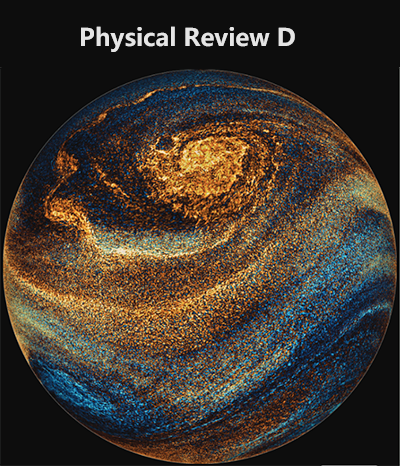Dynamics of dwarf galaxies in scalar-tensor-vector gravity
IF 5.3
2区 物理与天体物理
Q1 ASTRONOMY & ASTROPHYSICS
引用次数: 0
Abstract
We have investigated whether the Scalar-Tensor-Vector Gravity theory (STVG) may explain the kinematic of stars in dwarf spheroidal galaxies. STVG modifies General Relativity by adding extra scalar and vector fields with the main aim of replacing dark matter in astrophysical self-gravitating systems. The weak-field limit of STVG brings a Yukawa-like modification to the Newtonian gravitational potential. The modification is modulated by two parameters, $\alpha$ and $\mu$, that represent a redefinition of the gravitational coupling constant and the mass of the additional vector fields, respectively. Thus, adopting the modified gravitational potential arising in the weak-field limit of STVG, we have solved the spherical Jeans equation to predict the line-of-sight velocity dispersion profiles of eight dwarf spheroidal galaxies orbiting around the Milky Way. The predicted profiles are then compared to the data using a Monte Carlo Markov Chain algorithm. Our results pointed out some tensions on the $\alpha$ parameter within the data set, while comparison with previous analysis shows the effectiveness of STVG in replacing dark matter with extra massive fields. Further improvements will require more sophisticated modelling of the line-of-sight velocity dispersion which will be possible as soon as high-precision astrometric data in dwarf spheroidals will become available.标量张量矢量引力中矮星系的动力学
我们研究了标量-张量-矢量引力理论(STVG)是否可以解释矮球状星系中恒星的运动。STVG通过添加额外的标量场和向量场来修正广义相对论,其主要目的是取代天体物理自引力系统中的暗物质。STVG的弱场极限给牛顿引力势带来了汤川式修正。修正由两个参数$\alpha$和$\mu$调制,这两个参数分别代表引力耦合常数和附加矢量场质量的重新定义。因此,我们采用修正的STVG弱场极限产生的引力势,求解了球形Jeans方程,预测了围绕银河系运行的8个矮球状星系的视距速度色散曲线。然后使用蒙特卡洛马尔可夫链算法将预测的轮廓与数据进行比较。我们的结果指出了数据集中$\alpha$参数的一些张力,而与先前的分析比较表明STVG在用额外质量场代替暗物质方面的有效性。进一步的改进将需要更复杂的视距速度色散模型,一旦高精度的矮球天体测量数据可用,这将成为可能。
本文章由计算机程序翻译,如有差异,请以英文原文为准。
求助全文
约1分钟内获得全文
求助全文
来源期刊

Physical Review D
ASTRONOMY & ASTROPHYSICSPHYSICS, PARTICLES-PHYSICS, PARTICLES & FIELDS
CiteScore
9.30
自引率
36.00%
发文量
3456
期刊介绍:
Physical Review D (PRD) is a leading journal in elementary particle physics, field theory, gravitation, and cosmology and is one of the top-cited journals in high-energy physics.
PRD covers experimental and theoretical results in all aspects of particle physics, field theory, gravitation and cosmology, including:
Particle physics experiments,
Electroweak interactions,
Strong interactions,
Lattice field theories, lattice QCD,
Beyond the standard model physics,
Phenomenological aspects of field theory, general methods,
Gravity, cosmology, cosmic rays,
Astrophysics and astroparticle physics,
General relativity,
Formal aspects of field theory, field theory in curved space,
String theory, quantum gravity, gauge/gravity duality.
 求助内容:
求助内容: 应助结果提醒方式:
应助结果提醒方式:


